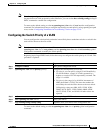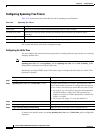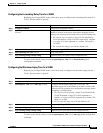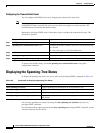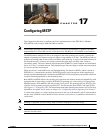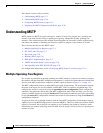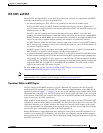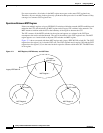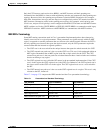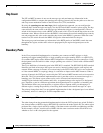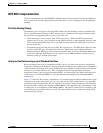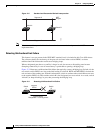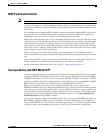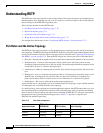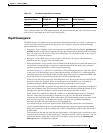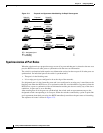
17-5
Catalyst 2960 and 2960-S Switch Software Configuration Guide
OL-8603-09
Chapter 17 Configuring MSTP
Understanding MSTP
Only the CST instance sends and receives BPDUs, and MST instances add their spanning-tree
information into the BPDUs to interact with neighboring switches and compute the final spanning-tree
topology. Because of this, the spanning-tree parameters related to BPDU transmission (for example,
hello time, forward time, max-age, and max-hops) are configured only on the CST instance but affect all
MST instances. Parameters related to the spanning-tree topology (for example, switch priority, port
VLAN cost, and port VLAN priority) can be configured on both the CST instance and the MST instance.
MSTP switches use Version 3 RSTP BPDUs or IEEE 802.1D STP BPDUs to communicate with legacy
IEEE 802.1D switches. MSTP switches use MSTP BPDUs to communicate with MSTP switches.
IEEE 802.1s Terminology
Some MST naming conventions used in Cisco’s prestandard implementation have been changed to
identify some internal or regional parameters. These parameters are significant only within an MST
region, as opposed to external parameters that are relevant to the whole network. Because the CIST is
the only spanning-tree instance that spans the whole network, only the CIST parameters require the
external rather than the internal or regional qualifiers.
• The CIST root is the root switch for the unique instance that spans the whole network, the CIST.
• The CIST external root path cost is the cost to the CIST root. This cost is left unchanged within an
MST region. Remember that an MST region looks like a single switch for the CIST. The CIST
external root path cost is the root path cost calculated between these virtual switches and switches
that do not belong to any region.
• The CIST regional root was called the IST master in the prestandard implementation. If the CIST
root is in the region, the CIST regional root is the CIST root. Otherwise, the CIST regional root is
the closest switch to the CIST root in the region. The CIST regional root acts as a root switch for
the IST.
• The CIST internal root path cost is the cost to the CIST regional root in a region. This cost is only
relevant to the IST, instance 0.
Table 17-1 on page 17-5 compares the IEEE standard and the Cisco prestandard terminology.
Table 17-1 Prestandard and Standard Terminology
IEEE Standard Cisco Prestandard Cisco Standard
CIST regional root IST master CIST regional root
CIST internal root path cost IST master path cost CIST internal path cost
CIST external root path cost Root path cost Root path cost
MSTI regional root Instance root Instance root
MSTI internal root path cost Root path cost Root path cost



